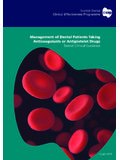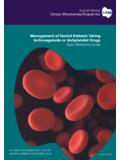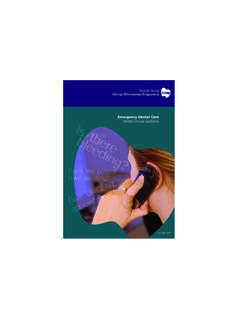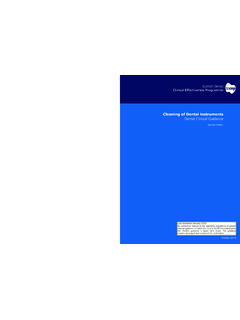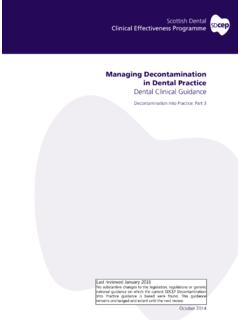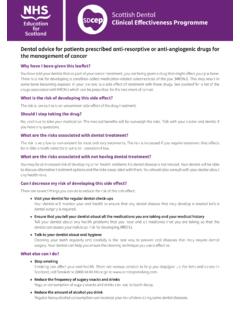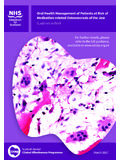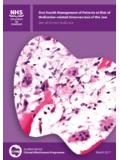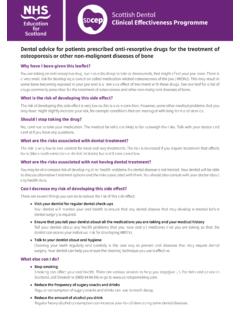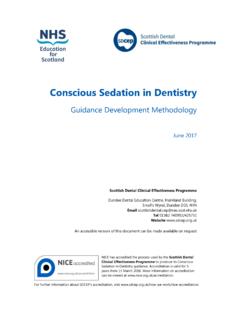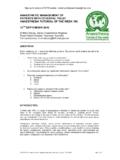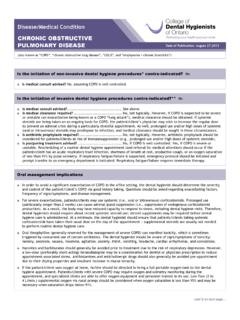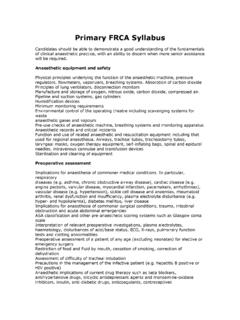Transcription of Management of Acute Dental Problems - SDCEP
1 Management of Acute Dental Problems Guidance for healthcare professionals March 2013 Scottish Dental Clinical Effectiveness Programme SDCEP operates within NHS Education for Scotland. You may copy or reproduce the information in this document for use within NHS Scotland and for non-commercial educational purposes. Use of this document for commercial purpose is permitted only with written permission. First published March 2013 Scottish Dental Clinical Effectiveness Programme Dundee Dental Education Centre, Frankland Building, Small s Wynd.
2 Dundee DD1 4HN Email Tel 01382 425751 / 425771 Website iii1 Introduction 1 Why this guidance has been developed 1 Scope of the guidance 1 How the guidance is presented 2 Who should use this guidance 2 Statement of Intent 3 2 Overarching Principles 4 Critically Unwell Patients 4 Timescales for Treatment 4 Management of Spreading or Systemic Infection 4 Drug Interactions 5 Adverse Drug Reactions 5 Patient Assessment and Record Keeping 6 3 Pathways to Providers of Care Decision Support 7 Patient with Pain 8 Patient with Swelling 10 Patient with Bleeding 11 Patient with Trauma 12 Patient with Ulceration 14 Patient with Altered Sensation or Abnormal Appearance in the Head and Neck 16 Decision Support Pathway Endpoints 17 4 Management of Oral Conditions 20 Common Conditions Acute Apical Abscess 20 Acute Pericoronitis (including Erupting Teeth in Children)
3 21 Acute Periodontal Conditions 22 Dentine Hypersensitivity 24 Pulpitis 25 Alveolar Osteitis (Dry Socket) 26 Post-extraction Haemorrhage 27 Oral Ulceration 28 Cracked, Fractured, Loose or Displaced Tooth Fragments and Restorations 30 Ill-fitting or Loose Dentures 31 Orthodontic Problems 32 Sinusitis 32 Less Common Oral Conditions Injuries to the Mouth.
4 Face and Jaws 34 Acute Temporomandibular Joint Conditions 37 Bell s Palsy 38 Salivary Gland Obstruction or Infection 39 Candidal Infection (Oral Thrush) 40 Intra-oral Swellings and Abnormal Appearance 41 Management of Acute Dental Problems Management of Acute Dental Problems iv Rare Oral Conditions Anaesthesia, Paraesthesia, Dysaesthesia 42 Angioedema 43 Osteonecrosis 44 Peri-implantitis 44 Temporal Arteritis 45 Trigeminal Neuralgia 46 5 Audit and Research 47 Recommendations for Audit 47 Recommendations for Research 47 Appendix 1 Guidance Development 48 The Scottish Dental Clinical Effectiveness Programme 48 The Guidance Development
5 Group 48 The Programme Development Team 49 Methodology 50 Review and Updating 52 Steering Group 52 Appendix 2 Analgesia 54 Providing Self Care Advice on Managing Dental Pain Analgesic Prescribing for Pain Relief Appendix 3 Adverse Drug Reactions and Side Effects 61 Appendix 4 Glossary 66 Management of Acute Dental Problems Why this guidance has been developed The clinical services provided for patients with Acute Dental Problems are variable (Ball, 2008; Anderson, 2005; Anderson, 2000).
6 Some patients may have to re-attend for a procedure to be repeated or for alternative treatment because the initial care had provided little or no relief from symptoms. Patients attending for unscheduled care with pain or infection that requires a clinical intervention may be prescribed antibiotics inappropriately (Ellison, 2008; Runyan, 2004; Sweeney, 2004). For less frequently encountered Problems , such as Dental trauma and certain medical conditions, there might be more uncertainty about the care that should or can be provided (Tulip, 2008).
7 Notably, a significant proportion of the population only seek Dental care when they suffer an Acute episode and may initially present to other providers of care ( general medical practitioner, accident and emergency, pharmacy). The World Health Organisation (WHO) has suggested a range of Oral Health targets for 2020 (Hobdell, 2003). These include an increase in the number of health care providers who are competent to recognise and manage a range of Acute Dental Problems (infectious diseases, oral mucosal and salivary gland disorders).
8 The proposed targets also promote the early detection and appropriate referral pathway for a variety of oral conditions, including Dental trauma, oro-pharyngeal cancers and oral diseases and disorders. Recognising the diverse manner in which patients requiring unscheduled clinical care are managed, the Scottish Dental Clinical Effectiveness Programme ( SDCEP ) convened a guidance development group to support the delivery of safe and effective patient care by providing clinical guidance on best practice for the Management of Acute Dental Problems .
9 The guidance developed by this multidisciplinary group builds on the Emergency Dental Care guidance published by SDCEP in 2007, the experience of managing Dental calls within NHS 24 and research evidence on treatment of the wide range of conditions that may present ( SDCEP , 2007). Further information about development of this guidance is provided in Appendix 1. Scope of the guidance The guidance aims to encourage a consistent approach to the Management of Acute Dental Problems to reduce avoidable variation in practice improve the quality of unscheduled clinical care for patients with Acute Dental Problems provide a standard for the initial Management of presenting symptoms for patients with Acute Dental Problems ensure patients receive appropriate advice about subsequent care and/or referral to appropriate treatment providers.
10 If applicable The guidance focuses on initial Management and subsequent care to address the presenting problem . Longer term care planning is beyond the scope of this guidance. The guidance is based on guidelines, systematic reviews and other published literature and the opinion of experts and experienced practitioners. The guidance is applicable to patients of all ages in all population groups, irrespective of the healthcare setting or whether or not they are regular attenders for routine Dental care. 1 Introduction Management of Acute Dental Problems How the guidance is presented Overarching Principles are presented in Section 2.
